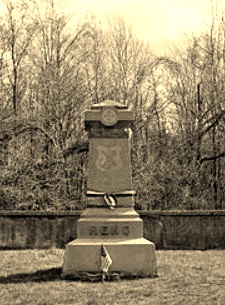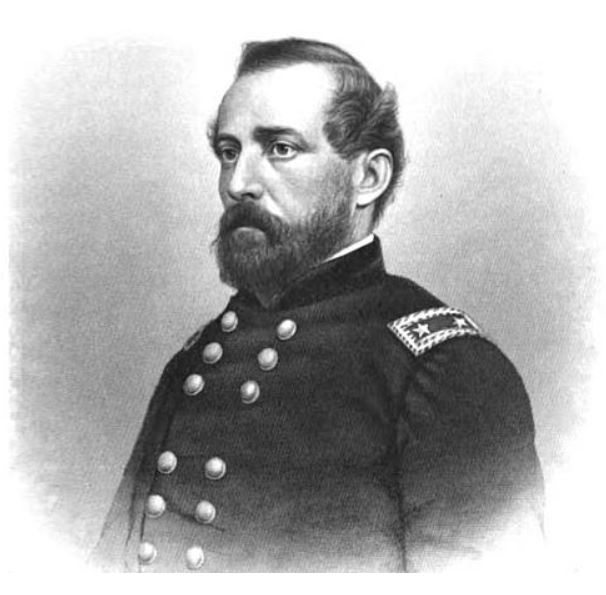On the evening of September 14, 1862 as the sounds of the day’s battle began to fade away and night spread its cloak of darkness across the eastern face of South Mountain, Oliver Case of the 8th Connecticut along with the other soldiers of IX Corps received disturbing news. In spite of lying in battle positions with the threat of Confederate sharpshooting from the summit, the word spread quickly about the death of the IX Corps’ commanding general, Jesse Lee Reno. In command of the corps for just over two months since Ambrose Burnside had sent him with the corps to support John Pope’s failed campaign in northern Virginia, Reno had become respected and beloved by his troops.
Ironically, Jesse Reno was a Virginian by birth. The third of eight children of Lewis and Rebecca Reno, Jesse was born in Wheeling, Virginia (later West Virginia) on June 20, 1823. His family descended from French immigrants who arrived in the American colonies in 1770 and promptly changed their name from the French surname “Reynaud” to the more palatable Reno. When Jesse was only seven years old, the family left Virginia and moved to Franklin, Pennsylvania where he would spend his remaining childhood and attend school. Reno gained admission to the United States Military Academy in 1842 joining many other future Union and Confederate generals such as Pickett, A.P. Hill, McClellan, Stoneman, Couch and Thomas J. Jackson. During his years at West Point, Jesse and Thomas Jackson would become close friends.
Jesse Reno graduated number eight of 59 cadets in his class in 1846 with an appointment as a second lieutenant of ordnance. Like Jackson and many of his classmates, Reno would fight under General Winfield Scott in the Mexican War in 1847 including the battles at Cerro Gordo, Contreras, Chumbusco and Vera Cruz. He was twice cited for bravery in battle receiving battlefield promotions at Cerro Gordo and Chapultepec. While in command of howitzer battery at the Battle of Chapultepec, Reno was severely wounded.
In the post-war years, Reno served in various locations including Washington, West Point, Minnesota and Utah. In November 1853, he married Mary Blanes Cross of Boston at St. John’s Episcopal Church in Washington D.C. Their marriage would produce five children.
As the winds of war began to blow through the country, Reno received an assignment as the commanding officer of the Mount Vernon Arsenal in Mobile, Alabama in 1859. As the secession debate moved through the southern states, the governor of Alabama ordered the seizure of the arsenal on January 4, 1861. Reno’s detachment of only 18 soldiers was no match for the four companies of Alabama state militia sent to the arsenal by the governor. Captain Reno surrendered the post without bloodshed and led his soldiers back to the north. Reno was placed in charge of the Army’s arsenal at Fort Leavenworth, Kansas until December 1861 when his services would be requested elsewhere.
Jesse Reno was promoted to Brigadier General with an effective date of November 12, 1861 as requested by General Ambrose Burnside. Burnside was gathering an expeditionary force at Annapolis, Maryland for operations along the southern coastline and appointed Reno as the commander of its 2nd Brigade which included among its regiments the 51st New York, 51st Pennsylvania, 21st Massachusetts, 9th New Jersey, and the 6th New Hampshire. After training and equipping his brigade, Reno led them in Burnside’s expeditionary operations in North Carolina at New Bern, Roanoke Island and Fort Macon. In these battles, Reno proved his skill and acumen as a battlefield commander by leading his brigade in difficult operational and logistical situations. His troops gained a great deal of respect for him as a leader who cared for his soldiers and inspired them to fight.
After Burnside received orders to relocate the bulk of his force to Virginia to support George McClellan’s faltering Peninsula Campaign, Reno was promoted to Major General on July 12, 1862. Placed in command of the newly formed IX Corps, by August Reno received orders to move the bulk of his corps to northern Virginia in order to support General John Pope. In late August, Jesse Reno and Thomas Jackson, close friends and West Point classmates, would meet on the field of battle at Manassas and Chantilly.
With Pope’s Army beaten and retreating into the Washington defenses, Reno and the IX Corps were again placed under the command and control of Ambrose Burnside along with the I Corps commanded by Joseph Hooker. On September 7, 1862 with George McClellan returned to command of the Army of the Potomac, IX Corps moved north out of Washington in pursuit of the Army of Northern Virginia now on move into Maryland. The movement of his corps as part of the entire Army of the Potomac was a significant logistical challenge for Major General Reno.
A famous incident from the march illustrates one of the many challenges Reno faced. IX Corps had been reinforced by the addition of a fourth division; the Kanawha Division made up of western regiments and commanded by General Jacob Cox. These western regiments were often maligned by the eastern soldiers and viewed as somewhat undisciplined troops. One of those regiments, the 23rd Ohio, was commanded by a future President of the United States, Lieutenant Colonel Rutherford B. Hayes. As the columns halted for the evening, Hayes ordered his troops to remain in battle formation for the night versus forming en masse due to the advanced position of the regiment. As the soldiers began to prepare to bed down for the evening, they helped themselves to a local farmer’s haystacks to make more comfortable bedding.
About this time, General Reno arrived and sternly admonished Hayes on the conduct of his men reminding him that the army was in friendly territory and was forbidden from looting private property. In defense of his men, Colonel Hayes sharply responded to Reno, “I trust our generals will exhibit the same energy in dealing with our foes that they do in the treatment of their friends.” In a sure sign of his respect for Hayes’ determined support of his troops, Reno rode off from the scene and never mentioned the incident to General Cox, the division commander.
Arriving in Frederick, Maryland on September 12, 1862, Reno and the IX Corps troops were greeted as heroes. Their stay would be short-lived as the corps moved to Middletown the next day and onward to South Mountain the following day. After a day of intense day of fighting at Fox Gap (detailed in a previous post), General Reno rode forward to recon the lines and determine his next move.
Rather than go directly to the right flank, Reno chose to start at his left and ride along the entire front length of his line, commending his troops for their excellent progress and battle conduct. About halfway across the line and in an exposed position, Reno stopped to observe the enemy’s position with a telescope. Musket fire suddenly erupted from the confederate line and Reno was struck by a bullet that lodged in his chest.[1]
Reno was quickly evacuated from the lines and brought first to the location of one of his division commanders, Samuel Sturgis. He immediately spoke to Sturgis, “Hello Sam, I am dead!” Due to the strange nature of his comments, Sturgis believed it to be a joke and responded that he hoped it was not that bad. Reno replied, “Yes, yes. I’m dead. Goodbye.”
As he was being attended to by his surgeon, Calvin Cutter, Major General Jesse Reno uttered his last words, “Tell my command that if not in body, I will be with them in spirit.” He died with the love and concern for his soldiers on his mind.
The loss of Reno was a major blow to the IX Corps and the Union Army. He was memorialized by many:
The greatest loss of all was that of General Reno…In all the acts of his life his fine and generous qualities of character were made manifest…he was a thorough soldier, and fully deserved all that his superiors in command have said of him…He had a magnetic kind of enthusiasm, and when leading on his men, he seemed to inspire his followers and make them irresistible in action. A dauntless soldier, whose like we rarely see![2]
From his superior and friend, Ambrose Burnside:
By the death of this distinguished officer the country loses one of its most devoted patriots, the army one of its most thorough soldiers. In the long list of battles in which General Reno has fought in his country’s service, his name always appears with the brightest luster, and he has now bravely met a soldier’s death while gallantly leading his men at the battle of South Mountain. For his high character and the kindly qualities of his heart in private life, as well as for the military genius and personal daring which marked him as a soldier, his loss will be deplored by all who knew him, and the commanding general desires to add the tribute of a friend to the public mourning for the death of one of the country’s best defenders.[3]
And, a derisive comment from the Confederate commander who opposed him at Fox Gap on South Mountain, Major General D.H. Hill:
The Yankees on their side lost General Reno, a renegade Virginian, who was killed by a happy shot from the Twenty-third North Carolina.[4]

The Reno Monument at Fox Gap on South Mountain
[1] The Latin Library biography of Jesse Reno, accessed from http://www.thelatinlibrary.com/chron/civilwarnotes/reno.html
[2] Major General Ambrose E. Burnside and the Ninth Army Corps, Augustus Woodbury, Sidney S. Rider & Brother, Providence, 1867.
[3] General Order No. 17, Major General Ambrose Burnside.
[4] OR, Series I, Vol. XIX, Part I, Chap. XXXI.

